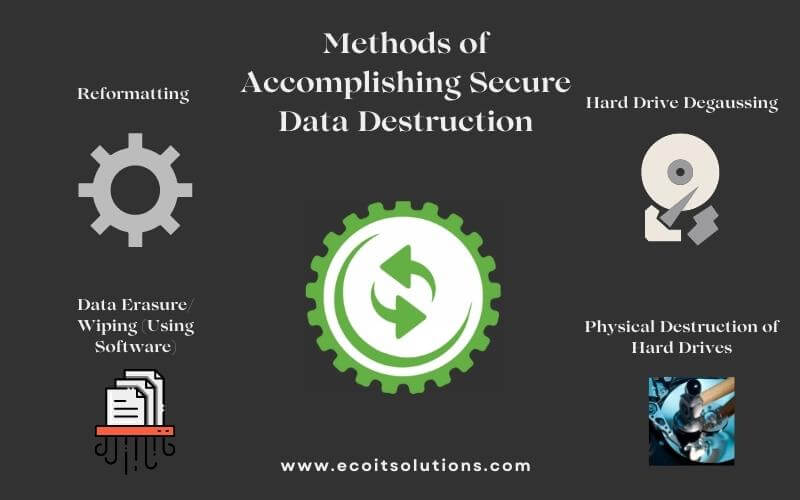Necessary Cyber Security Practices for Effective Data Destruction Techniques
Necessary Cyber Security Practices for Effective Data Destruction Techniques
Blog Article
How Proper Information Damage Adds To Robust Computer System Safety And Security Providers and Mitigates Risks of Information Violations
In today's electronic landscape, the significance of appropriate information destruction can not be overemphasized, as it offers as an essential component of detailed computer system protection services. The ramifications of poor information destruction extend beyond simple conformity; they can greatly affect an organization's cybersecurity position and track record.
Relevance of Data Destruction
In today's electronic landscape, the relevance of information damage can not be overemphasized. As companies significantly depend on digital assets, the potential risks connected with data breaches and unauthorized access amplify. Effective data destruction is a vital part of a thorough details protection approach, guarding delicate info from falling under the hands of destructive stars.
When data is no longer required, simply erasing files or formatting hard disks wants. Recurring data can commonly be recuperated using readily available devices, posing significant risks to both companies and individuals. This emphasizes the need for durable information damage methods that guarantee all information is irretrievably gotten rid of.
Furthermore, governing conformity requireds, such as GDPR and HIPAA, stress the responsibility to safeguard sensitive information, including its appropriate disposal. Non-compliance can result in severe economic penalties and lawful consequences. data destruction. Therefore, incorporating efficient information devastation protocols not just improves safety and security yet likewise fortifies an organization's track record and credibility

Methods of Secure Data Erasure
Numerous effective techniques of safe data erasure can be used to guarantee that sensitive information is permanently removed from storage space gadgets. One widely acknowledged strategy is information overwriting, which includes replacing existing information with random patterns multiple times. This method significantly minimizes the opportunities of data healing, although it might not work versus innovative forensic techniques.

Physical destruction is also a dependable strategy, where storage tools are rendered unusable with shredding, crushing, or incineration. This method makes certain that data can not be recovered whatsoever but needs mindful handling of dangerous products.
Finally, specialized software tools designed for secure information erasure give functionalities that adhere to numerous erasure criteria. These devices commonly consist of functions like verification processes to confirm effective information damage.
Utilizing these methods in mix can boost information protection and minimize the threats linked with information violations, making certain that delicate details is not accidentally revealed.
Legal and Conformity Considerations
The techniques utilized for secure information erasure not only offer to protect delicate information however also needs to align with lawful and compliance structures governing information protection. Organizations are called for to follow numerous guidelines, such as the General Data Defense Guideline (GDPR), the Wellness Insurance Mobility and Responsibility Act (HIPAA), and the Repayment Card Industry Data Security Requirement (PCI DSS) These regulations mandate specific methods for information dealing with and devastation, making sure that sensitive and individual data is irretrievably gotten rid of when no longer needed.
Failure to abide by these lawful requirements can result in considerable read review fines, consisting of fines and reputational damage. Furthermore, companies have to maintain records of data damage procedures, showing see page compliance during audits or investigations. This paperwork not just shields against legal repercussions however additionally reinforces trust fund with consumers and stakeholders, showcasing a dedication to information safety and security.
Integrating lawful and conformity factors to consider into data damage techniques is necessary for any organization. It lessens the danger of information breaches and shows an aggressive approach to protecting delicate details, eventually cultivating a society of safety and accountability throughout the company.
Effect on Cybersecurity Position
Effective information destruction substantially boosts a company's cybersecurity pose by decreasing the potential attack surface area for cyber threats. When delicate data is not properly ruined, it stays available to destructive stars who can manipulate this information for unauthorized accessibility, identity burglary, or business reconnaissance. By carrying out robust information damage protocols, organizations can properly decrease the risk of information breaches and improve their general safety and security structure.
Furthermore, the secure disposal of unnecessary or outdated information not only secures sensitive details however additionally assists companies abide by industry guidelines and standards. Failing to effectively destroy data can result in serious legal consequences and reputational damage, additional endangering an organization's cybersecurity position.

Eventually, prioritizing effective data devastation is vital for cultivating a durable cybersecurity posture, guaranteeing that organizations stay vigilant against evolving cyber risks while safeguarding their vital possessions and stakeholders.
Ideal Practices for Organizations
Applying ideal techniques for information devastation is crucial for companies intending to guard delicate info and alleviate cybersecurity threats. Primarily, companies must establish an extensive data destruction plan that lays out treatments and obligations. This policy must comply with relevant guidelines, such as GDPR or HIPAA, making certain legal conformity.
Second of all, it is important to use approved data sanitization approaches, including information wiping, degaussing, and physical devastation, tailored to the kind of data and storage space medium. Using certified professionals for information devastation solutions improves the reliability of these techniques.
Furthermore, companies should keep an in-depth inventory of all data storage space devices, ensuring that all outdated or changed devices undertakes destruction. Routine audits of data destruction techniques can help boost and identify weaknesses conformity.
Employee training is another essential aspect, as personnel has to understand the value of data destruction and follow developed protocols. Ultimately, companies should document all data devastation tasks to give liability and traceability, which can be indispensable throughout audits or in the occasion of a breach.
Final Thought

One commonly recognized method is information overwriting, which includes replacing existing data with arbitrary patterns multiple times.The techniques used for safe data erasure not just offer to safeguard delicate details but additionally should line up with lawful and compliance frameworks controling data protection. These laws mandate details methods for information handling and devastation, making certain that personal and sensitive data is irretrievably eliminated when no longer required.
By implementing robust information damage procedures, companies can properly minimize the danger of information breaches and enhance their general protection structure.
In verdict, proper information devastation is essential for enhancing computer safety and security services and mitigating the risks associated with data breaches. - data destruction
Report this page